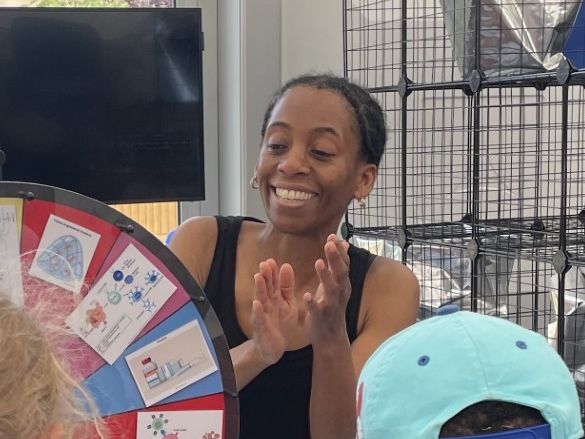Cheltenham Science Festival 2025 - Part 1: A View from the Tent
11 June 2025
In this first of two reflections on "a whirlwind week of controlled chaos", RESILIENCE Outreach champion Dr. Bernice Wright shares stories, views and lessons learned from taking part in one of the UK's leading public science festivals.

The annual Cheltenham Science Festival sees events and shows taking place across the historic Georgian spa town in Gloucestershire, but is centred around the elegant Imperial Gardens where a set of large marquees contain a myriad of scientific delights and mysteries for the young and young at heart alike.
A rush of enthusiasm
This year’s Festival started on Tuesday 3rd June with a rush of enthusiasm and excitement as crowds of excited children came through the doors of the Discover Zone where both RESILIENCE’s display and a cooperative second display with the UK Innovation Hubs teams were situated. Schools are prioritised at the festival with groups of children supervised by teachers to attend the 10am-3pm sessions, and families invited to afternoon sessions.
The RESILIENCE and Innovation Hubs teams worked continuously to entertain the school groups in hourly sessions of controlled chaos. For the children and teachers, the first day of the festival was the beginning of an exciting week of a broad range of STEM learning opportunities that included learning about modern advanced medicine in a fun and accessible way. The family session run immediately after the school session of the first day of the festival felt comparatively serene, but everyone had a tremendous adventure across the week.
VR - the star of the show…
Virtual reality was the star activity on both the RESILIENCE and Innovation Hubs stands. The children engaged with a FourPlus simulation that introduced them to a lab space to perform basic pipetting procedures, use a light microscope to observe cells on a haemocytometer, use weighing scales, and handle chemicals used to measure the acidity and alkalinity of buffer solutions. There was always a flurry of delight from the children and teachers when we projected VR simulations onto a screen. The children were really blown away to see their friends’ engagement with the lab in the virtual space.

…but not the only show in town
At the Innovation Hub stand, a rather lower tech kind of modelling - in clay - proved to be rather popular. The range of bio-science related models attempted were truly impressive – the most complicated structure anyone had a go at was a cell membrane containing glycoproteins. Water tattoos were so popular, even the teachers wanted one! The opportunity to collaborate with Innovation Hubs at the Cheltenham Science Festival is the beginning of an important strategic direction to share ideas and approaches for STEM outreach.

Back on the RESILIENCE stand, our ‘Wheel of Medicine’ that involved spinning a wheel to match medicines to their mechanisms of action was quite a hit, even if the medicines it portrayed were advanced and their mechanisms complex. The children enjoyed the challenge of getting the correct matches and they even brought their friends along to try their luck. The various interpretations for building lab apparatus using Lego were creative, sometimes curious (the attempts to build a microfluidic chip were rather unique!), but always thoughtful.

The molecular modelling activity also drew in crowds. A key challenge that the most switched-on children managed to decipher for themselves was figuring out how to form a double bond (by bending in the flexible bond connectors to match the available bond ‘hole’ angles). Most children took to the models with minimal or no help and top-end primary pupils were determined to build their chemical models correctly according to the example structures provided by our illustrative cards. Younger vistors, by contrast, enjoyed the creative freedom to unleash their imagination on building their own molecular structures, and this gave our team unexpected opportunities to talk (in age-appropriate terms!) about how molecular structure affects macro-scale properties like phase behaviour, visco-elasticity and crystallinity.

Bringing science within reach of everyone
We were delighted when a group of hearing impaired children visited the RESILIENCE stand and their teacher signed instructions for modelling chemical structures. They then visited the Innovation Hubs stand, where they engaged with the VR without any issues. Our VR demo involved practising the important lab skill of pipetting, so it was quite a cool link up that real-world pipetting was also available on the RESILIENCE tabletop, and proving to be a consistent favourite. The children pipetted designs (a bacteriophage, an adenovirus, and the shape of a pipette itself) into 96-well plates. The youngest child to try pipetting was about four years old and too small to reach the table, but impressively, she was able to use a micropipette to pipette 200 µL of the ‘reagent’ (coloured water) into a 96-well plate.

The feedback from children for the activities they’d engaged in was mainly positive. The few ‘not sure’ replies about activities were from children who had limited time to engage with what tehy were doing as they were ushered to the next stand by teachers. Our custom-made ED&I and feedback booklet which we used to collect feedback data for each activity proved to be a successfully and ingeniously simple tool for the job and the children really enjoyed our emoji-based method for expressing their views.

Read more from Bernice in Part 2, “Where do we go from Here?” where she tells a few more stories of fun, and extracts a few lessons from communication of cutting-edge science at the Cheltenham Science Festival…

